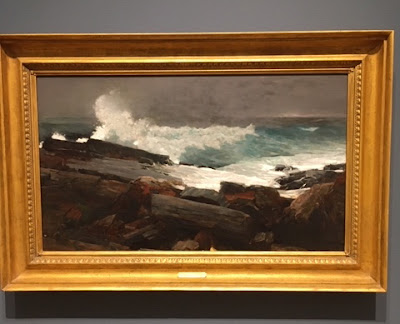Winslow Homer and Edward Hopper: Artists Learning from Each Other
Winslow Homer, Weatherbeaten, oil on canvas, 1894
Portland Museum of Art, Maine
I was traveling in the last month. First to Portland, Maine where I attended Greenhut Galleries opening for their exhibition Maine: The Painted State that included one of my paintings. Also visited the Portland Museum of Art and soaked up one of their hallmark Winslow Homer oils, Weatherbeaten. It was painted just south of the Museum in Prouts Neck. Nobody painted surf crashing on rocks with the power and authority Homer achieved.
Notice the deliberate way Homer painted his rocks. Ignoring details he paid special attention to their color. In the detail above we see how he marches our eye back into space with alternative bands of warm and cool. His closest rocks are reddish, a cooler gray on the next rocks farther back, followed by a warm dark colored finger of rock. Finally we reach the silvery cool green-grays of the surf.
And Homer was something of a disciplinarian with his waves. In the detail above he maneuvers his white surf into clear and geometric flat shapes that are visually just as arresting as his massive rocks.
After Portland I flew out to Ohio to see the Charles Burchfield exhibition at Cleveland Museum of Art and to visit Allen Memorial Art Museum in Oberlin. Andria Derstine, the Allen's Director told me about how exciting the Toledo Museum of Art's collection is and urged me to squeeze in a side trip to see it. Art junkie that I am, I set my alarm to wake up early the next morning and headed off.
Winslow Homer, Sunlight on the Coast, oil on canvas, 1890,
Toledo Museum of Art
Toledo Museum of Art was full of gems. One in particular that caught my eye was another of Homer's Prouts Neck surf paintings (above). I realize Homer recycled the basic shape of the crashing wave in this earlier Toledo painting in his Portland oil done four years later. But by adding more surrounding space and casting a completely different light over the water the result is ingeniously inventive and fresh.
As people who know me are more than aware, the artist Edward Hopper's work has been the most powerful influence on my own direction as a painter. It was seeing his work that inspired me to change from painting abstractions to working as a realist.
Edward Hopper, Rocks and Swirling Water, oil on panel,
1916-19, Whitney Museum of American Art
Of course all painters are influenced by the artists who have gone down the path before them. Hopper was no exception. Early in his career he spent important time on Monhegan Island off the coast of Maine and painted dozens of rocks and waves oils. The one above shows him experimenting with Homer's deep and brooding tonalities. To me there's no question that Hopper had looked very closely at Homer's rocky shorelines.
Philip at Cleveland Museum of Art with Edward Hopper's
Hills, South Truro, oil on canvas, 1930
Hopper of course was too much his own soul to stay for long in the shadow of his mentors. Over time his characteristic fascination with clear lighting and slightly simplified forms emerged. While I was at Cleveland Museum of Art I had to pay my respects to their Hopper masterpiece, Hills, South Truro. Pained years later than his rocks and surf oil shown above, it evokes an almost penetrating stillness.
I'm especially fond of Cleveland's Hopper as it celebrates Hopper's discovery on his first summer on Cape Cod of the spot where four years later he would design and build his painting studio (on the spot right above my left shoulder in the photo above). My wife Alice and I have had the good fortune to have enjoyed 17 residencies in that studio.
Philip Koch, Edward Hopper's Kitchen: Open Door, oil on
canvas, 40 x 60 inches, 2019
This is one of my paintings of the inside of the studio's kitchen. Look out the window at the left and you see where Hopper set up
his easel to paint Cleveland's Hills, South Truro.









